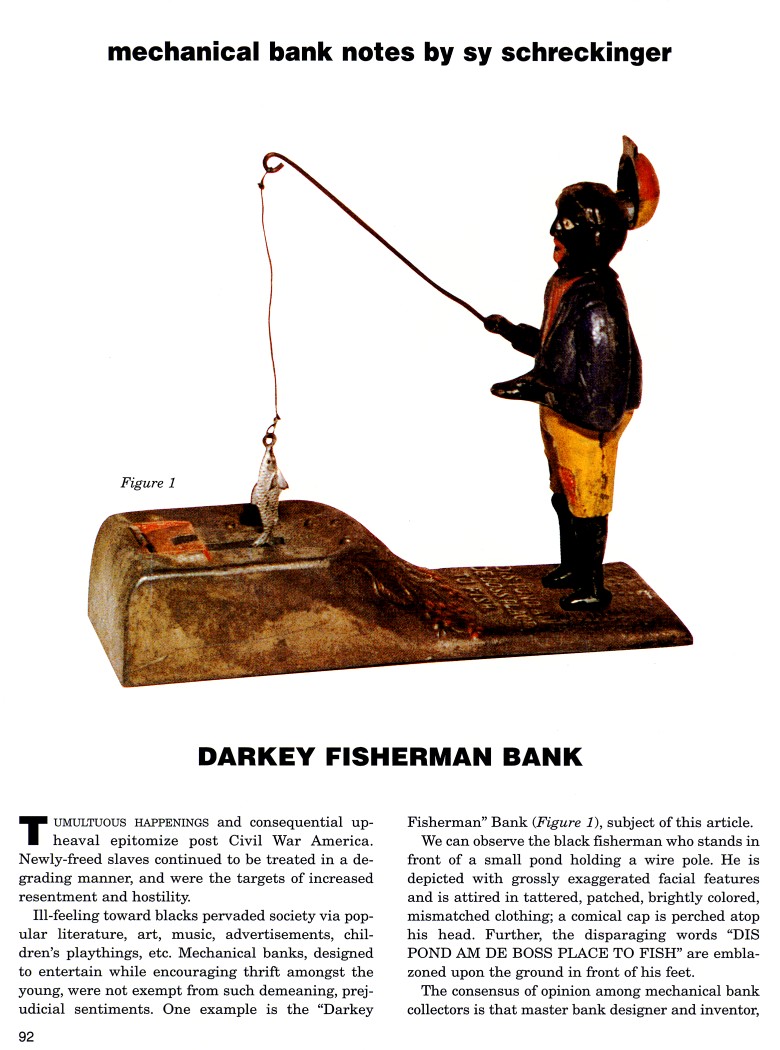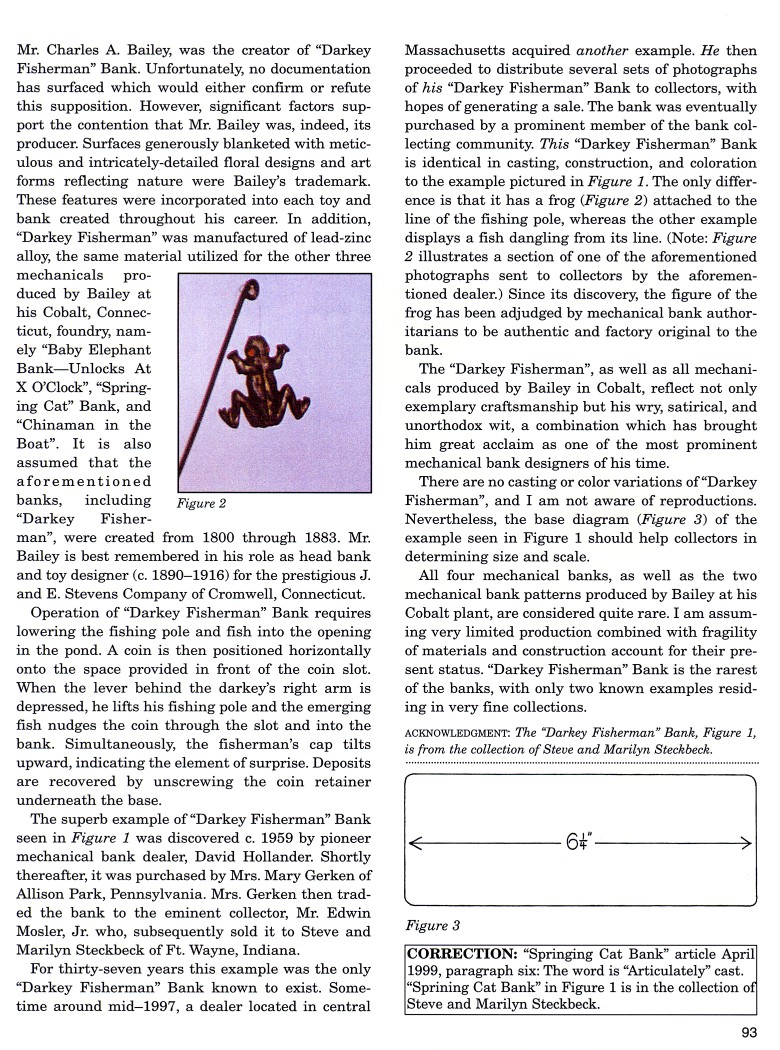|
Darkey Fisherman Bank
by Sy Schreckinger – ANTIQUE TOY WORLD Magazine – May, 1999
Tumultuous
happenings and consequential upheaval epitomize post Civil War America.
Newly-freed slaves continued to be treated in a degrading manner, and were
the targets of increased resentment and hostility.
Ill-feeling toward blacks pervaded society via
popular literature, art, music, advertisements, children's playthings,
etc. Mechanical banks, designed to entertain while encouraging thrift
amongst the young, were not exempt from such demeaning, prejudicial
sentiments. One example is the "Darkey Fisherman" Bank (Figure 1), subject
of this article.
We can observe the black fisherman who stands in
front of a small pond holding a wire pole. He is depicted with grossly
exaggerated facial features and is attired in tattered, patched, brightly
colored, mismatched clothing; a comical cap is perched atop his head.
Further, the disparaging words "DIS POND AM DE BOSS PLACE TO FISH" are
emblazoned upon the ground in front of his feet.
The consensus of opinion among mechanical bank
collectors is that master bank designer and inventor, Mr. Charles A.
Bailey, was the creator of "Darkey Fisherman" Bank. Unfortunately, no
documentation has surfaced which would either confirm or refute this
supposition. However, significant factors support the contention that Mr.
Bailey was, indeed, its producer. Surfaces generously blanketed with
meticulous and intricately-detailed floral designs and art forms
reflecting nature were Bailey's trademark. These features were
incorporated into each toy and bank created throughout his career. In
addition, "Darkey Fisherman" was manufactured of lead-zinc alloy, the same
material utilized for the other three mechanicals produced by Bailey at
his Cobalt, Connecticut, foundry, namely "Baby Elephant Bank — Unlocks At
X O'Clock", "Springing Cat" Bank, and "Chinaman in the Boat". It is also
assumed that the aforementioned banks, including "Darkey Fisherman", were
created from 1800 through 1883. Mr. Bailey is best remembered in his role
as head bank and toy designer (c. 1890-1916) for the prestigious J. and E.
Stevens Company of Cromwell, Connecticut.
Operation of "Darkey Fisherman" Bank requires lowering the fishing
pole and fish into the opening in the pond. A coin is then positioned
horizontally onto the space provided in front of the coin slot. When the
lever behind the darkey's right arm is depressed, he lifts his fishing
pole and the emerging fish nudges the coin through the slot and into the
bank. Simultaneously, the fisherman's cap tilts upward, indicating the
element of surprise. Deposits are recovered by unscrewing the coin
retainer underneath the base.
The superb example of "Darkey Fisherman" Bank seen in Figure 1 was
discovered c. 1959 by pioneer mechanical bank dealer, David Hollander.
Shortly thereafter, it was purchased by Mrs. Mary Gerken of Allison Park,
Pennsylvania. Mrs. Gerken then traded the bank to the eminent collector,
Mr. Edwin Mosler, Jr. who, subsequently sold it to Steve and Marilyn
Steckbeck of Ft. Wayne, Indiana.
For thirty-seven years this example was the only "Darkey Fisherman"
Bank known to exist. Sometime around mid-1997, a dealer located in central
Massachusetts acquired another example. He then proceeded to distribute
several sets of photographs of his "Darkey Fisherman" Bank to collectors,
with hopes of generating a sale. The bank was eventually purchased by a
prominent member of the bank collecting community. This "Darkey Fisherman"
Bank is identical in casting, construction, and coloration to the example
pictured in Figure 1. The only difference is that it has a frog (Figure 2)
attached to the line of the fishing pole, whereas the other example
displays a fish dangling from its line. (Note: Figure 2 illustrates a
section of one of the aforementioned photographs sent to collectors by the
aforementioned dealer.) Since its discovery, the figure of the frog has
been adjudged by mechanical bank authoritarians to be authentic and
factory original to the bank.
The "Darkey Fisherman", as well as all mechanicals produced by Bailey
in Cobalt, reflect not only exemplary craftsmanship but his wry,
satirical, and unorthodox wit, a combination which has brought him great
acclaim as one of the most prominent mechanical bank designers of his
time.
There are no casting or color variations of "Darkey Fisherman", and I
am not aware of reproductions. Nevertheless, the base diagram (Figure 3)
of the example seen in Figure 1 should help collectors in determining size
and scale.
All four mechanical banks, as well as the two mechanical bank
patterns produced by Bailey at his Cobalt plant, are considered quite
rare. I am assuming very limited production combined with fragility of
materials and construction account for their present status. "Darkey
Fisherman" Bank is the rarest of the banks, with only two known examples
residing in very fine collections.
ACKNOWLEDGMENT: The "Darkey Fisherman" Bank, Figure 1, is from the
collection of Steve and Marilyn Steckbeck.
CORRECTION: "Springing Cat Bank" article
April 1999, paragraph
six: The word is "Articulately" cast. "Sprining Cat Bank" in Figure 1 is
in the collection of Steve and Marilyn Steckbeck.
|


